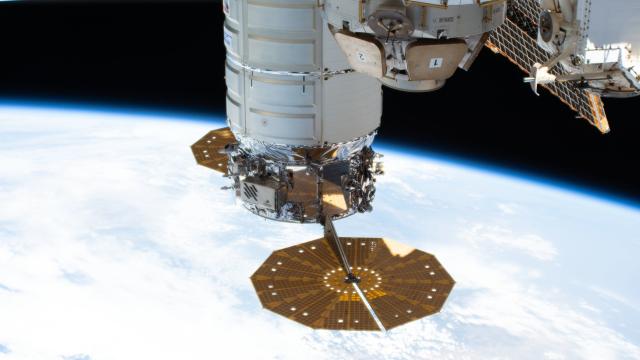NASA is breathing a sigh of relief following a successful demonstration in which a docked Cygnus freighter was temporarily converted into a booster engine for the International Space Station. The favourable test suggests NASA has the means to adjust the space station’s orbit should Russia decide to leave the orbital outpost, as the Kremlin has threatened to do.
The limited reboost test happened on Saturday June 25 and it lasted for 5 minutes and 1 second, according to NASA. The Northrop Grumman Cygnus spacecraft managed to raise the International Space Station’s altitude by approximately 161 metres at apogee (an object’s greatest orbital distance to Earth) and 805 metres at perigee (nearest distance to Earth). The space station orbits Earth at an altitude of roughly 418 kilometres.
That Cygnus was able to perform this feat is not a huge surprise, as the vehicle performed a similar test in 2018. The difference here, however, is that Cygnus’s gimbaled delta velocity engine was used for the reboost, making this mission “the first to feature this enhanced capability as a standard service for NASA,” the space agency said.
The test on Saturday was the second attempt to perform the ISS reboost. On June 20, NASA and Northrop Grumman terminated the test after just 5 seconds. The newly completed test “incorporated lessons learned from [the] earlier reboost attempt that was suspended as a precautionary measure,” Northrop Grumman explained in a press release. “Investigation by engineers showed that the observed parameters were as expected for the reboost and flight limits were adjusted for Saturday’s successful attempt.”
This demonstration of Cygnus as an ISS rebooster is likely a response to Russia threatening to leave the space station, possibly as early as 2025. Should Russia abandon the ISS, it would remove the only other current means for manoeuvring the ISS: the Progress spacecraft. The ISS requires an orbital adjustment from time-to-time, either the result of normal operations or to dodge wayward space junk.
“This reboost of the ISS using Cygnus adds a critical capability to help maintain and support the space station,” Steve Krein, vice president of civil and commercial space and tactical space systems at Northrop Grumman, said in the company statement. “It also demonstrates the enormous capability Cygnus offers the ISS and future space exploration efforts.”
As a relevant aside, the Space Shuttle was capable of serving as an ISS booster, as was the European Space Agency’s Automated Transfer Vehicle, but both options have been retired. In an email, Jonathan McDowell, an astrophysicist at the Harvard-Smithsonian Centre for Astrophysics, said the Russian Zvezda module can also perform the trick, but Progress vehicles are required to pump fuel in Zvezda and then detach prior to the reboost. Before the arrival of Zvezda, the Russian Zarya module was used for reboosts from 1998 to 2000, McDowell added.
The limited reboost test complete, NASA and Northrop Grumman are now in the midst of ending this particular Cygnus mission. The freighter, named Piers Sellers, arrived at the ISS on February 21 with 3,765 kg of supplies, hardware, and other cargo for NASA. As of 7:07 a.m. ET Tuesday, however, the vehicle is no longer attached to the space station. A deorbiting engine fire is scheduled for Wednesday June 29 to prompt a planned destructive entry. Filled with ISS trash, the expendable freighter will safely burn up in Earth’s atmosphere.
